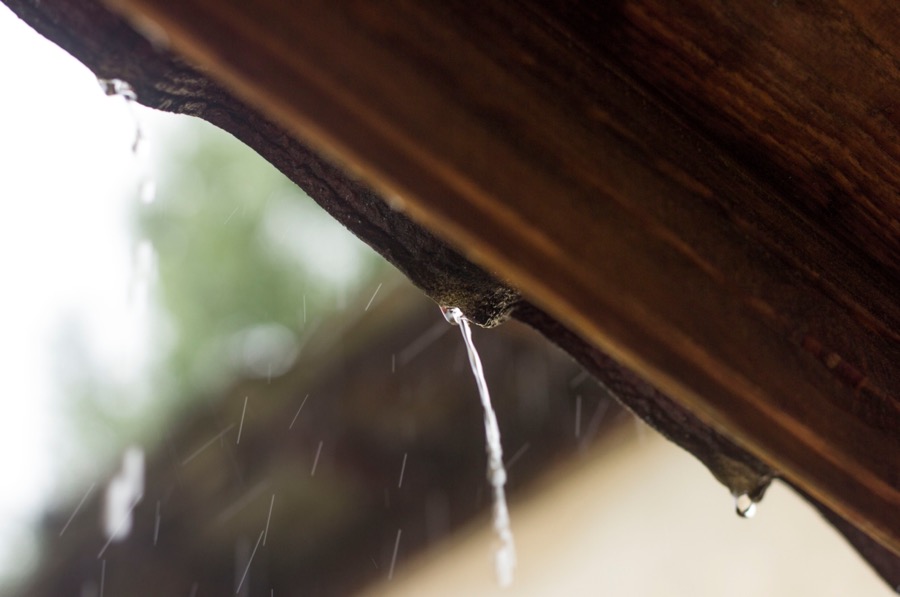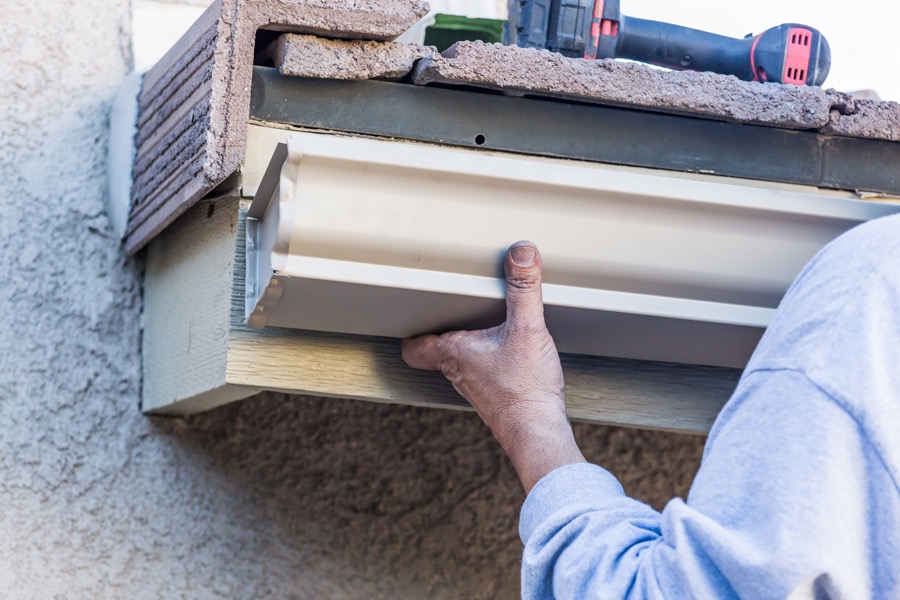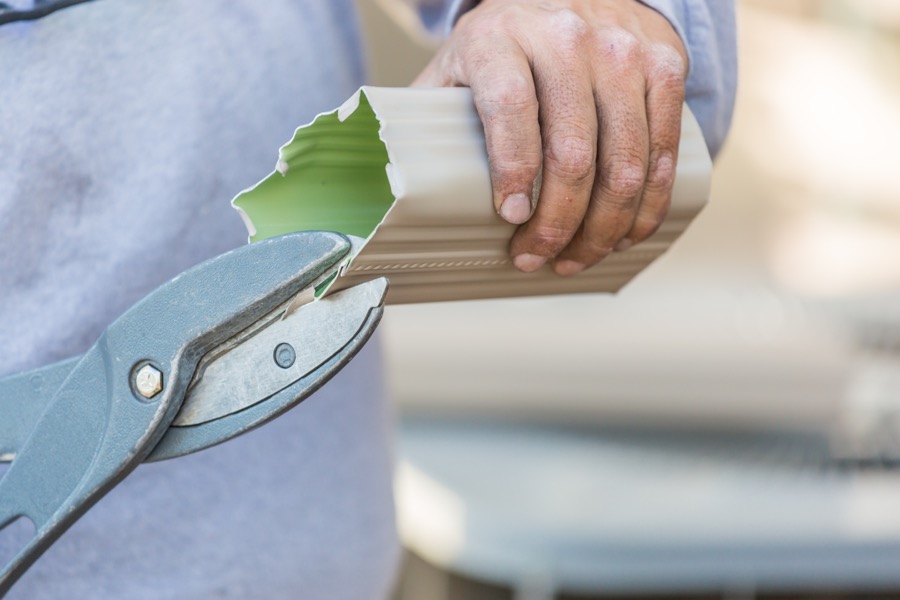
Home > Blog posts > Gutters for flat roofs: the complete guide
Gutters for flat roofs: the complete guide
On top of offering several layout options, flat roofs are also advantageous for several other reasons. It is also the preferred type of roof for commercial buildings, amongst others. However, water and debris evacuation is the main challenge that people with this type of roof are faced with.
In order to tackle this challenge properly, having a good drainage system is essential, and gutters are the perfect answer to this main concern. La Clinique de la toiture FCA provides you with a complete guide on gutters for flat roofs and explains the installation process.
Why are gutters important on a flat roof?
While sloped roofs evacuate water easily, the opposite is true for flat roofs. They are much more at risk of accumulating water which is why it is important to choose the most efficient solution possible.
In fact, water accumulation can cause several types of damages. The first is, of course, damages to your roof and its components, including the roofing. This can go even further: water accumulation can cause leaks and even structural damages to your house.
In the winter, this also means that your roof will have to withstand much heavier loads, including the weight of the ice! Other than accumulations, gutters also stop water from leaking onto the siding and reaching the foundations. In fact, gutters on a flat roof will evacuate water farther away from the building or the house.
For flat roofs, gutters represent one of the most efficient and affordable options, by efficiently protecting your structure from damages caused by water and the debris that accumulates with it. Moreover, it is a more affordable option than drains, which are generally preferred on larger buildings.

What types of gutters are best for flat roofs?
Since flat roofs and sloped roofs are different in how they evacuate water, gutters will be also different for each. Here are the types of gutters that are suited to flat roofs.
Types of gutters
As we have mentioned, some flat roofs have drains, which are strategically positioned over the roof surface. A slight incline will drive the water towards the drain; and then it will run through a pipe system placed under the roof in order to be evacuated. This system is efficient and does not freeze during the winter.
On the other hand, it does present some disadvantages, like being more expensive in terms of maintenance, and more often being clogged due to debris. And when a drain is clogged water accumulates, meaning that taking the proper precautions is key to success.
You will also have the option of having traditional gutters, or “rain gutters”. They are placed on the sides of the roofing and –more importantly- can be added at any time. They are particularly practical if you need to improve water evacuation on an already existing roof!
The main advantage is that they are quite affordable and require easy maintenance. However, just like drains, you will have to think about cleaning and maintenance. This will ensure that they work properly and that you avoid corrosion. They will also have to be properly positioned in order to evacuate water farther away from the foundations.
Drains, on the other hand, must be installed at the same time the roof is being built. They are not quite the same as a gutter, although sometimes both terms are confused. Instead of being installed with hooks, they are installed by a roofer.
In fact, drains work like gutters but inside the structure; they are invisible from the exterior. The only visible parts are the pipes that come out of the roof to evacuate the water out and away.
As for eavestroughs, they are wide openings on the roof’s edges that evacuate water out and away from the roof. They are sometimes combined with sloped exits, just like for gutters and drains.

Different gutter shapes for flat roofs
When shopping for gutters for your roof, you will notice that several different shapes are available to you. Those who have sloped roofs can choose any type they want, but a flat roof requires something more specific.
Generally speaking, you will have the choice between a round or square gutter. The first is mostly used in older constructions, while the second is preferred for buildings with flat roofs. Square gutters are part of the “hanging” gutter category. This means that it is fixed using hooks on the edges of the roof. It is an esthetically pleasing and discrete option.
How much do gutters for a flat roof cost?
Prices for you gutters will vary according to the type of gutter you have selected but –mostly- the material they are made from. Some types of gutters are also easier to install than others. Here are the main materials used and an average price per linear foot, including labor costs:
- Vinyl (PVC): $ 3.50 to $ 6 / linear foot
- Aluminum: $ 4.50 to $ 11 / linear foot
- Galvanized steel: $ 4.50 to $ 9.50 / linear foot
- Copper: $ 18 to $ 30 / linear foot
Each material obviously has its own properties. For example, vinyl is the least durable while copper can last for up to 100 years, on top of being very esthetically pleasing. On the other hand, it is much easier to install a vinyl gutter, which is also the least expensive option.
As for aluminum, it is mostly popular due to how light it is and the amount of color options it offers, which can also be made to match your siding. However, a color that is not standard can easily cause prices to climb.
When it comes to steel, it is often appreciated for how resistant it is to corrosion, which allows it to last a good 20 to 25 years, or even more. Maintenance obviously has an important role to play on your gutters’ durability or life span.
Installation costs can vary greatly depending on complexity: if your roof is very high or if your house’s architecture contains several obstacles, this will cause labor costs to rise.
So, total cost for gutters depends on several factors, without forgetting that it will also vary from one contractor to another. Do you want to save money? It is sometimes possible to install gutters on your own; as long as you know how!

How to install gutters on a flat roof?
The easiest or simplest way will always be to deal with a professional; but if you are good with your hands, you may be able to proceed with the gutter installation yourself. Moreover, you will save a significant amount of money by doing so, and this is a possibility that gutters offer that no other water evacuation system does!
However, some types of gutters cannot be installed by a homeowner, like those made of copper for example. Aluminum used to be custom made, but it is now possible to purchase a kit or sections that can be assembled together. When it comes to galvanized steel, it is always better to have them custom made by professionals.
As for vinyl, there are no such constraints: they are the easiest to install!
Keep in mind that simple does not mean it is child’s play. First and foremost, don’t forget that safety is key when completing this type of work. It is important that you get one or several ladders, along with other safety equipment like:
- Gloves
- Safety goggles
- A harnest
- A helmet.

You will also require other measurement tools that will be essential in order to determine the length, the amount of connections and elbows you will need.
Begin by making sure to purchase some hooks for your gutters, if you do not already have some in place. Then, the first step –before you actually install your gutters- will be to trace an outline of your future gutters. For this, you will need the following tools:
- A level
- A plumb-line
- A chalk line
- A measuring tape
- A hamer and nails
- A drill
- A saw for metal
Sometimes connections are glued (PVC), interlocked (aluminum) or soldered. You must get the required materials according to what is needed.
During the installation process, begin by assembling the elements on the ground, as this will make your job much easier. Once this is done, you can cut out the perfect length according to your needs. You will then be ready to install the gutters to the side of the roof on the appropriate hooks.
Do you need advice, maintenance or repairs for your flat roof? Do not hesitate to contact us at La Clinique de la toiture FCA, your flat roof experts!
Need help?
Leave us your email address and we will contact you as soon as possible to assess your needs!
Put an end to your water infiltration your clogged drains your roof problems
Leave us your email address and we will contact you as soon as possible to assess your needs!
